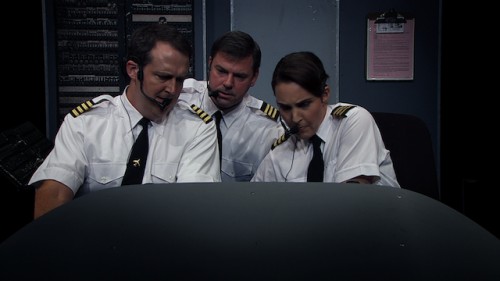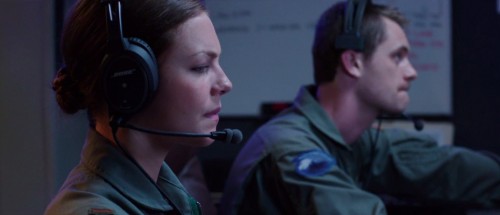AFI Fest 2013: Taking Flight, by Scott Nye
14 Nov
Not only does a film festival such as AFI Fest allow one to see so many films that one might not otherwise (either through simple scheduling or something as frustrating as the film not being available to see any other way), but the films end up informing each other, feeding off collective energy and enhancing the strengths and weaknesses of one another. Sometimes these connections only seem evident to the specific viewer, who is still turning them around in his or her head as another one is unfolding, but some just sitting there.
Crises in aviation, for example, drive both Charlie Victor Romeo and Drones. The former was produced as a theatre piece in New York and filmed in front of live audiences for its cinematic incarnation, but possesses none of the stilted awkwardness that typically accompanies plays recorded to video. That they shot it in 3D is not an insignificant factor. The effect isn’t so much that you feel, necessarily, like you’re sitting right there in the audience – the camera angles make that impossible – but rather like you’re sitting right there in the cockpit as a group of actors play out, almost exactly as they were recorded on the planes’ black boxes, one true aviation disaster after another. It’s a tense 81 minutes, to say the least, as even those disasters that came on suddenly, disrupting a seemingly quiet day in the air, are anticipated by the audience well in advance of their occurrence. The directors – Robert Berger, Patrick Daniels, and Karlyn Michelson – present the events simply and directly, informing us as to how many people were onboard, how many (if any) survived, and what caused the accident. Character is revealed reflexively, by the way the people make decisions. The limited sets might not lend themselves to verisimilitude (a black box recreated in a black box, if you will), but they enhance the terror – even in an unmoving space, no one is safe.
Drones, meanwhile, labors on with too much character, too much circumstance, too much effort. Nearly the whole film takes place in a trailer in the Nevada desert, in which Lieutenant Sue Lawson (Eloise Mumford) and Airman Jack Bowles sit and pilot unmanned aerial vehicles over Middle Eastern deserts, waiting to kill specific targets for unspecified reasons. Lawson is the daughter of a General, Bowles a high school graduate who’s just happy he landed as far as he got. This is Lawson’s first day in the drone program since being booted from the Air Force when they discovered her partially detached retina; she has major reservations about the morality of the program. There are some neat reversals in the last fifteen minutes or so, but by and large, this is a tiresome affair, full of scenarios elaborately constructed for an audience of which it assumes only the worst.
A different take on aviation and morality is at the center of The Wind Rises, the final film by legendary animator Hayao Miyazaki. Departing (though, given the film’s numerous breathtaking dream sequences, not entirely) from his familiar fantastical realms, Miyazaki tells a fictionalized biography of Jiro Horikoshi, the chief engineer of many Japanese fighter planes used during World War II, including one that played a prominent part in the attack on Pearl Harbor. This is important information to know up front, because such specifics are not the central concern of the film. It’s more general, universal, about how the purest ambitions can be warped by the times in which one lives, as opportunities are dictated by those with the money, and those with the money need motivations that might wildly differ from your own. Jiro is inspired by Giovanni Caproni, whose company produced bombers used by Italy, France, Great Britain, and the United States during the first World War. What catches Jiro’s eye is not the destructive aspect, but rather that an airplane designer could rise to such prominence and celebrity. In Jiro’s dreams, he speaks with Caproni about the film’s major thematic concerns, how the latter has big dreams for aviation once the war is over, and Miyazaki brings his subjects’ imaginations to glorious life, dreaming up the most impossible planes in the only realm that could sustain them.
The real Caproni would end up making only bombers and light transport vehicles after World War I, and geared right back up for the war machine when the second hit. He attempt to create a fascinatingly complex transatlantic passenger, but it crashed on its first flight. Like Jiro, his dreams were immense, but they each excelled only at what, in the film, they profess to look down upon. It’s a beautiful dichotomy to play with, but Miyazaki remains less focused on the results of such pursuits than the very act of pursuit. The result is far from the traditional biopic structure, even more a departure than its form would suggest, folding into the realm of speculative expression – Miyazaki is after Horikoshi’s intellect, his emotion, his dreams and passions, represented best by what I’m told is an entirely invented third act that sees one of the most heartbreaking romances of Japanese cinema since Naruse left it.













